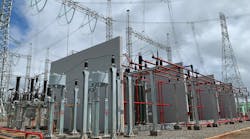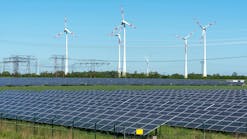Vietnam’s Development of Renewable Energy Resources
Vietnam, the Southeast Asian country with more than 98 million people has made exceptional economic progress in recent years. The country has made a significant shift to a market economy and transformed the nation to becoming one of the most dynamic emerging countries in the Southeast Asia region. Along with growing industrialization and economic modernization the demand for electrical energy is increasing.
The state-owned electric utility company, Vietnam Electricity (EVN), has seen the electricity consumption increase from 128.6 TWh in 2014 to 209.4 TWh in 2019 a growth rate higher than the increase in gross domestic product (GDP). The demand and consumption for electrical energy are predicted to continuously increase by over eight percent per annum between 2021-2030.
Vietnam's Government is proactively addressing this rapid pace of energy demand. With the recent draft of the eighth Power Development Plan (PDP VIII), the Ministry of Industry and Trade (MoIT) produced the power sector development roadmap through until 2045. From the first publication on, the plan showcases the commitment to reduce coal-fired power generation and continuously develop the renewable resources in Vietnam, increasing the target ambitiously to nearly 70% of renewable generation capacity by 2030 from 27 GW to 45 GW. Additionally, a further important element is the need for transmission and power system enhancements to facilitate and support the sizable increase in the intermittent generation from renewable energy resources.
Vietnam’s Existing Generation Resource
The country’s power market is currently considered as one of the most efficient in the region, utilizing coal, hydropower and natural gas as the main sources of energy. For power-hungry Vietnam, coal is currently cheaper, more reliable and more familiar than renewables. The installed forms of generation capacity in 2020 being 53% coal-fired, 26% hydropower, 16% natural gas and 5% non-hydro renewables.
However, due to the growing environmental concerns, reduced coal investments, and net-zero emissions, PDP VIII represents a new strategy supporting the Paris Climate Agreement (COP21) in 2015, by focusing on the expansion of renewable energy sources in the electricity mix.
Solar Energy Resources
The government has already started their investment and rapid advancement with the development for solar energy. In 2014, the installed solar and wind resources comprised only 1% of the country’s total installed generation capacity but by the end of 2019, renewable energies accounted for 5700 MW of installed capacity, representing about 10% of the total installed capacity, a significant achievement in five years.
In 2019, Vietnam surpassed Malaysia and Thailand in terms of installed solar energy resources by recording the largest installed capacity of solar panels in Southeast Asia with 5 GW of photovoltaic projects, far exceeding the 1 GW by 2020 target. There are now more than 101,000 rooftop solar systems installed over residential, commercial, and industrial premises across the country.
Wind Energy Resources
Simultaneously, the wind power industry in Vietnam is also increasing at an exponential rate. Blessed with a long coastline and exceptional wind resources, Vietnam is ideally placed to harness and maximize the potential of this wind power resource, thus it is expected to be one of the future leaders in onshore and offshore wind energy. The government has indicated an intent to substantially develop offshore and onshore wind from 600 MW in 2020 to some 12 GW in 2025 and over 18 GW in 2030.
This shift in focus inevitably poses some challenges especially on the significant capital requirements and current country infrastructure for interconnection availability. In a Draft Report, the MoIT forecasts that Vietnam will need about US$ 128.3 billion of investment to develop its electricity industry in the period 2021-2030, of which US$ 95.4 billion will be for power generation/source/plants and about US$ 32.9 billion will be for the transmission system. Digitization of the Transmission System.
The transmission system is a crucial element of the country’s critical infrastructure that needs to be secured and these infrastructure assets must operate reliably for decades in order to help to fundamentally change the power sector. The transmission system must also be stable and sufficiently robust to accommodate the wind and solar energy from where it’s most cost-effectively generated for transmission to the country’s load centers.
To handle such a complex transmission system, digitalization is an enabler that can assist the transmission system operators to increase energy efficiency and to employ these assets in a more productive, more reliable and safer manner. Digitalization means creating and collecting data — from sensors, automation equipment and whole assets, harnessing it for actionable insights to optimize grid operations, whether for handling a surge in demand, an overheating transformer or aging switchgear insulation. In practice, it is well-known that power producers and utilities are currently analyzing and applying less than 10% of their recorded available data resource. It is therefore essential that the data generated from in-field transmission assets is processed to maximize the utilization of the existing assets. Cloud-based analytics, edge computing and Internet of Things (IoT) enabled architecture are to make it possible to utilize the power of data.
Benefits of Digitization
A current example where digitization has proven to be a savior to the power sector by keeping the lights on, is the COVID-19 pandemic. Such events and their consequences are hard to predict. However, their impacts can be minimized with the help of digital products and systems that provide early indications of any significant risks to avoid a major outage. Other applications like remote monitoring, equipment health index, maintenance and control schedule and even the virtual acceptance tests of new equipment are in great demand after proven to be effective.
Development of Wind Energy
The Vietnam government and key industry players have slowly begun to address the transmission grid challenges while integrating more renewables projects into the country’s portfolio. Siemens Energy is an active player in the country’s transformation journey taking the lead in the transition to intelligent, safe, and efficient power grids.
Recent examples are the IaPet-Dak Doa 1 and IaPet-Dak Doa 2 wind farm projects constructed by Technology Resources Energy (TRE). These two wind farms are part of Vietnam’s ongoing Power Development Master Plan to further push the integration of renewable energy sources and enhance the power supply. Siemens Energy equipped the substation that connects the IaPet-Dak Doa 1 & 2 wind farms to the EVN transmission system. Among the other substation assets, Siemens Energy delivered digitally enhanced transmission products with advanced intelligence from the Sensproducts portfolio, including connective circuit-breakers, surge arresters and power transformers called Sensformers.
The digitalization journey for Siemens Energy’s transmission business started in 2018 when they introduced the Sensformer as the world’s first comprehensive digital transformer. Since then, they have steadily expanded the digital portfolio from the Sensformer to include the Sensgear, gas-insulated switchgear, circuit breakers, surge arresters, disconnectors, instrument transformers, and coil products. All these substation elements can now be equipped with connectivity via a smart and robust Internet of Things (IoT) gateway that securely transmits the required information to a cloud-based storage and visualization platform.
In an ever-complex energy landscape, where a large number of small generating units are being connected to the transmission system, the volatile feed-in of renewable energies challenges grid stability. The conversion of substations into data hubs is an important step to future-proof the grids and increase the competitiveness of renewable energies.
IaPet-Dak Doa 1 and IaPet-Dak Doa 2 Wind Farms
The Sensformer units for the IaPet-Dak Doa 1 and IaPet-Dak Doa 2 wind farms have advanced features and come with a digital twin, a synchronized thermo-replication of the physical asset, that acts like a twin of the real unit and allow the operator to manage temporary overloads without compromising on the transformers’ lifetime. It uses the ambient and equipment information as the basis for the prediction of how the real unit reacts to a particular transient event.
Siemens Energy supplied and installed three 500 kV Sensformers and two 220 kV Sensformers, three 500 kV and six 200 kV connective circuit-breakers with advanced trending as well as 15 connective surge arresters rated at 500 kV. Sensgear advanced upgrades functionality of connected circuit breakers enhances productivity by using a digital twin and artificial intelligence. Operators for example, are obliged to pay special attention to SF6, a greenhouse gas with high global warming potential and widely used in high-voltage applications. Frequent inspection visits of the equipment, reporting on inventory and emissions, which are more and more connected to penalties will be undertaken continuously driving-up operating costs.
Sensproducts with integrated F-gas reporting provide remote inventory measurement in each gas-compartment, SF6 and CO2 emission calculations, reporting periods and summaries. Faster and more accurate gas trending and prediction is possible by applying AI models for optimized gas monitoring.
Sensarresters allow the operators to check the surge arrester’s status via online applications in near real-time and thus increase efficiency and sustainability of their assets and operations. The connectivity of the Sensarrester device is done with a smart and robust IoT gateway securely transmitting a minimum amount of required information to a cloud-based storage and visualization platform, providing operators with a comprehensive and quick overview about their assets.
The field operator is able to check the status of the substation assets via online applications in real-time to increase efficiency and availability of operations. Additionally, the company delivered conventional disconnectors, instrument transformers and current limiting reactors.
The commissioning and energization of the substation was completed in Oct. 2021. The IaPet-Dak Doa one and IaPet-Dak Doa two wind farms together include 44 wind turbines which are expected to generate a gross energy of some 532,600 MWh annually.







